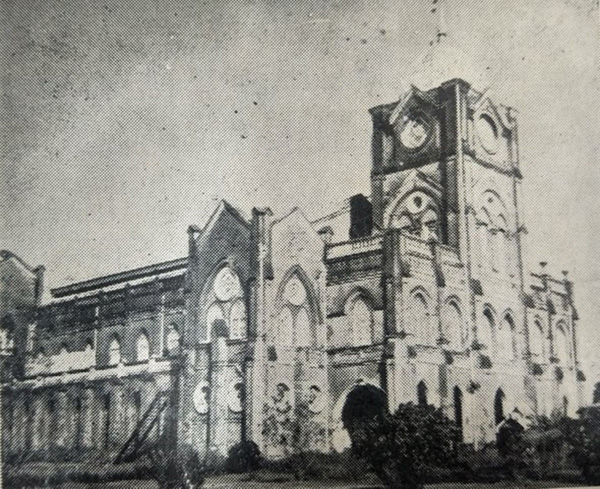The National Library of Myanmar originated from the Bernard Free Library, the first free public library in the country.
The library, which was established 137 years ago, first opened at the current site of the No.1 Basic Education High School in Latha opposite Yangon General Hospital on Bogyoke Aung San Road. It was the most famous library in Myanmar until World War II.
The library was established on Feb. 21, 1883, by the commissioner of lower Myanmar (then Burma), Sir Charles Edward Bernard, two years before the whole country fell under colonial rule. He was the first chief commissioner of British Burma who announced the occupation of the entire country.
The library was free to use and open to all, containing Bernard’s collection of books as well as manuscripts and parabaik, written in the Mon, Burmese and Pali languages donated by officials, scholars and community elders.
When the British occupied the royal capital, Mandalay, soldiers looted the royal palace. As they searched for gems and jewelry, manuscripts and parabaik were scattered and damaged. Many were burned as waste.

The remaining manuscripts and parabaik were divided into three groups: one sent to the king of Thailand; another to the India secretary in London and the third collected at the Bernard Free Library. The manuscripts of Myanmar’s last monarch, King Thibaw, were added to the library’s archive.
With government expenditure, collectors were sent across the country to collect manuscripts and parabaik, either through donation, purchase or copying from the original.
The library employed permanent staff to make copies of any manuscripts collected. It was the most comprehensive library in the country in terms of the value of its manuscripts, Burmese prose and poetry and the historical significance of its contents.
British administrative officials used the library to learn the history, language, customs and traditions. Judges also used it for reference. The wooden building allowed residents to acquire a knowledge of Britain.
The founder of the nationalist movement, Thakhin Kodaw Hmaing, said he read almost all the manuscripts and parabaik at the library. It was also a resource for writers, scholars and artists who tried to preserve the national literature and culture that was being suppressed under foreign rule.
Well-known writers from Rangoon University (now Yangon University) like Theippan Maung Wa, who was a civil servant in the colonial government, relentlessly contributed to the promotion of indigenous literature in British Burma through the Bernard Free Library. Scholars relied on the library to resurrect the Burmese language and literature – which were neglected under the British – to be taught at the city’s university.

The Bernard Free Library was divided between European and Asian books. Some European books dated back three centuries.
Journals from the Royal Society for Asian Affairs and periodicals from across Asia were housed at the library. It contained Burmese books of plays that were printed in the 1860s as well as books written in Pali, Mon and Karen.
Manuscripts by Kinwun Mingyi U Kaung, a chief minister during the reigns of King Mindon and King Thibaw, were added to the library in 1921. In 1924, the library purchased manuscripts of other scholars and officials like U Tin, who was known for his knowledge of Bagan.
It was said at the time that the library had any book one could imagine.
Another library was established at the city’s university, which held rare books, manuscripts, parabaik, stone inscriptions and books in foreign languages.
But the Bernard Free Library remained the only one accessible to all.

The author Zeya said: “We had never been to colleges and universities. However, the Bernard was the university for the poor, which provided the higher-level knowledge to the poor for free.”
Ahead of World War II, the library was moved to the city’s municipal office. The collection included 20,305 printed books and 7,588 manuscripts between 1940 and 1942. It was abandoned during the war and many books were damaged or lost.
U Thein Han (also known as the writer Zawgyi) arranged for the remaining books and manuscripts to be stored at a monastery in Shwedagon Pagoda.
Most of the manuscripts and parabaik were recovered after the war but around 70 percent of the books were lost. The Bernard Free Library was re-established in 1948 and handed over to the Culture Ministry of Anti-Fascist People’s Freedom League government in 1952. It was moved to the Jubilee Hall and its name was changed to the National Library.
From 1952 to the 2000s, the library moved to around seven places and more books were lost in the process.
The name Bernard Free Library is largely forgotten and today’s National Library in Yangon’s Yankin Township houses manuscripts, parabaik and some books that were first collected in the Bernard Free Library.
Translated from Burmese by Thet Ko Ko
You may also like these stories:
The House That Shaped Myanmar’s History
Myanmar’s Panglong Monument Embodies a Promise of Democracy, Autonomy and Equality
Yangon Zoo, the Oldest One in Southeast Asia

















